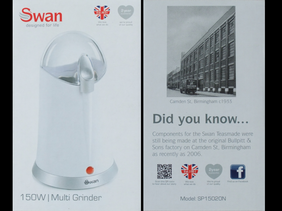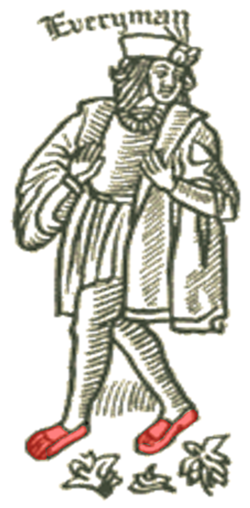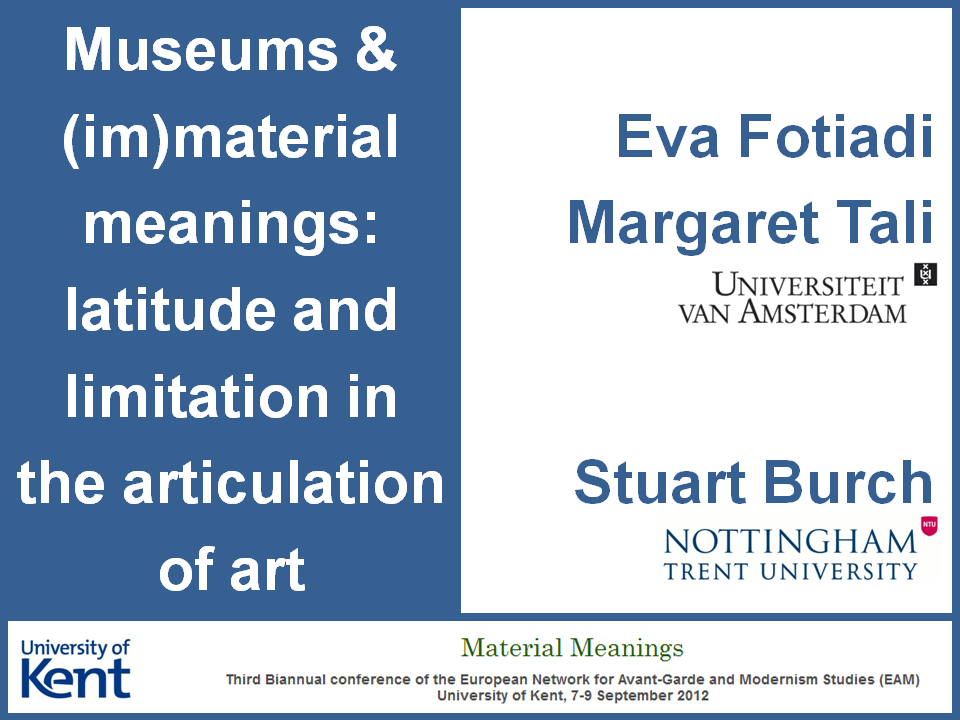|
On Monday 29th July 2013 I was invited to the University of Leeds to address the Science, Technology & Industry in Museums (STIM) subject specialist network. Its members met to discuss current trends in science and industry displays under the mantra “Into the light: bringing science, technology and industry collections out of the shadows”.
The presentation I delivered took as its starting point a series of exhibition reviews commissioned by the Museums Journal. These include evaluations of recent developments at Blists Hill Victorian Town (Ironbridge Gorge Museum), “Search Engine” (National Railway Museum, York) and “We Made It: Nuts, Bolts, Gadgets and Gizmos” (Birmingham’s science museum, Thinktank). The last-named exhibition celebrated a time when Birmingham could claim to be “the workshop of the world”. But what, I wondered, is manufactured there today? Has the workshop shut down completely? |
A purchase I made recently at my local branch of John Lewis crystallised this uncertainty (see image). Despite appearances to the contrary, Swan’s very British-looking coffee grinder isn’t made in Britain. Nevertheless, the packaging’s evocation of Birmingham’s vanished industrial heritage has evident marketing potential among customers nostalgic for an era when items were emblazoned with “Made in Britain”.
The decline of manufacturing in this country provides the subtext for David Lodge’s very funny novel, Nice Work of 1988. And it also provided the title for my talk:
“Nice, necessary work: reflections on STI, STEM and stuff”. The abstract for my presentation read as follows:
To turn the past into heritage is to transform it into a commodity: a good to be sold or exchanged. Anything has heritage potential.
A site of toil, for example, or tools of some redundant trade can get co-opted into another business – that of the heritage industry.
Just like its predecessors, this sector of the economy is staffed by a spirited and industrious workforce.
Their “nice work” will form one strand of my presentation. It will be paired with “necessary work” – those STEM subjects
deemed to be crucial to the so-called rebalancing of the economy. The result will be critically engaged and provocative
examination of the museum and heritage sector in the light of current debates surrounding science, technology and industry.
The decline of manufacturing in this country provides the subtext for David Lodge’s very funny novel, Nice Work of 1988. And it also provided the title for my talk:
“Nice, necessary work: reflections on STI, STEM and stuff”. The abstract for my presentation read as follows:
To turn the past into heritage is to transform it into a commodity: a good to be sold or exchanged. Anything has heritage potential.
A site of toil, for example, or tools of some redundant trade can get co-opted into another business – that of the heritage industry.
Just like its predecessors, this sector of the economy is staffed by a spirited and industrious workforce.
Their “nice work” will form one strand of my presentation. It will be paired with “necessary work” – those STEM subjects
deemed to be crucial to the so-called rebalancing of the economy. The result will be critically engaged and provocative
examination of the museum and heritage sector in the light of current debates surrounding science, technology and industry.
|
The paper “Everyone their own curator: Carl Becker’s ‘Mr Everyman’ and the inclusive museum” was accepted by the conveners of the Sixth International Conference on the Inclusive Museum: Museums and Active Citizenship (National Art Gallery of Denmark – Statens Museum for Kunst – Copenhagen, Denmark, 22-24 April 2013). In my talk I referred to Carl Becker’s 1931 speech ‘Everyman his own historian’. This was deployed as a means of considering the role that so-called ‘ordinary citizens’ can and should play in today’s inclusive museums.
Abstract: ‘Everyman his own historian’ declared Carl Becker in his famous 1931 presidential address to the American Historical Association. In making this pronouncement, Becker warned his fellow historians that their ‘antiquarian research’ risked gathering dust ‘behind glass doors rarely opened’. His solution? ‘Living history’, by which he meant the sort of accessible, relevant ‘history that does work in the world’. History for everyone, by everyone. Becker’s call to arms has particular resonance for the role that so-called ‘ordinary citizens’ can and should play in our inclusive museums. Today, technologies beyond Becker’s wildest dreams give ‘voice, amplified and freed from static’ to every museum visitor. Meanwhile, an online service such as Pinterest turns all users into curators. This fulfils a prediction made by John Berger in his seminal work, Ways of Seeing. Berger argued provocatively and persuasively that these homemade galleries ‘should replace museums’. So, does the fact that everyone is their own curator mean the dawn of inclusivity or the death knell of the museum? And if Becker was right when he gave the upper hand to Mr Everyman, what implications does this have for museums, ‘antiquarian research’ and collections that languish ‘behind glass doors rarely opened’? |
|
The third biannual conference of the European Network for Avant-Garde and Modernism Studies (EAM) was hosted by the University of Kent. Its overarching theme – “Material Meanings” – provided the inspiration for a panel I put together with Margaret Tali (School of Cultural Analysis, University of Amsterdam / Sandberg Academy of Arts) and Eva Fotiadi (University of Amsterdam / Gerrit Rietveld Academy of Arts). Our session was entitled, “Museums and (im)material meanings: latitude and limitation in the articulation of art”. |
My paper, “Immaterial meanings: moot, mute, Moderna Museet” reflected on the experience gleaned from writing an abortive peer reviewed study of Sweden’s Moderna Museet. This was withdrawn shortly after publication on the grounds that it “question[ed] the professionalism and integrity of specific individuals” in a manner that was “too speculative and personal” to merit inclusion in an academic journal. My argument was, in other words, immaterial, i.e. “of no essential consequence; unimportant” (Oxford English Dictionary).
In “Nation space and collector’s space”, Margaret Tali argued that the space of the national gallery has become differentiated. The main characteristics rendering this apparent were presented. Margaret advanced two paradigms for analyzing the display spaces of national galleries, namely collector’s space and nation space. Drawing examples from different European art museums, Margaret demonstrated how these twin notions can serve as tools for analysing the display practices of museums and help to understand their practices of materialising meanings.
Eva Fotiadi looked into process- and event-based art projects and their subsequent materialization in museum archives and later exhibitions. Examples span early 1960s pioneer interactive exhibitions like Dyllaby and Op Losse Schroeven and their re-telling in the 2011 exhibition Recollections (Stedelijk Museum Amsterdam), to Rikrit Tiravanija: A Retrospective (Tomorrow is Another Fine Day) (Museum Boijmans van Beuningen), which attempted to recapture a number of the artist’s relational gallery projects. The material manifestation of these and all such artistic afterlives require selective interpretation of the core meanings of the original “event” or “process”, plus a translation of the initial artwork – be it in terms of documentation or re-enactment
In “Nation space and collector’s space”, Margaret Tali argued that the space of the national gallery has become differentiated. The main characteristics rendering this apparent were presented. Margaret advanced two paradigms for analyzing the display spaces of national galleries, namely collector’s space and nation space. Drawing examples from different European art museums, Margaret demonstrated how these twin notions can serve as tools for analysing the display practices of museums and help to understand their practices of materialising meanings.
Eva Fotiadi looked into process- and event-based art projects and their subsequent materialization in museum archives and later exhibitions. Examples span early 1960s pioneer interactive exhibitions like Dyllaby and Op Losse Schroeven and their re-telling in the 2011 exhibition Recollections (Stedelijk Museum Amsterdam), to Rikrit Tiravanija: A Retrospective (Tomorrow is Another Fine Day) (Museum Boijmans van Beuningen), which attempted to recapture a number of the artist’s relational gallery projects. The material manifestation of these and all such artistic afterlives require selective interpretation of the core meanings of the original “event” or “process”, plus a translation of the initial artwork – be it in terms of documentation or re-enactment
Not NOW! Homepage histories and teacherly tweets
Annual Learning & Teaching conference, Nottingham Trent University, 27th-28th March 2012
My website took to the stage at NTU's learning and teaching conference. I used this event as an opportunity to reflect on one of the original motivations for this modest venture into cyberspace, namely the withdrawal from publication of a peer-reviewed journal article. The presentation (available here) also led to some interesting discussion about the potential tensions between the personal opinions expressed on this website and my academic profile as an employee of Nottingham Trent University. Watch this space!
Annual Learning & Teaching conference, Nottingham Trent University, 27th-28th March 2012
My website took to the stage at NTU's learning and teaching conference. I used this event as an opportunity to reflect on one of the original motivations for this modest venture into cyberspace, namely the withdrawal from publication of a peer-reviewed journal article. The presentation (available here) also led to some interesting discussion about the potential tensions between the personal opinions expressed on this website and my academic profile as an employee of Nottingham Trent University. Watch this space!
Heritage in Danger and Dangerous Heritage: Reflections on Politics, Participation and Preservation
Kalejdoskop - Sätt att se på kulturarv (Kaleidoscope - Ways to View Cultural Heritage), Hotell Södra Berget, Sundsvall, 14th-15th March 2012
My thoughts on heritage in danger and dangerous heritage were set out in a keynote address delivered to the delegates of "Kaleidoscope", the title of a conference held in Sundsvall, Sweden. The following day - 15th March - witnessed a series of fascinating talks (in Swedish) under the title "Disturbing Homogeneity" (Att störa homogenitet). The programme of speakers is available here. For the background to this event, contact Anna Molin.
Kalejdoskop - Sätt att se på kulturarv (Kaleidoscope - Ways to View Cultural Heritage), Hotell Södra Berget, Sundsvall, 14th-15th March 2012
My thoughts on heritage in danger and dangerous heritage were set out in a keynote address delivered to the delegates of "Kaleidoscope", the title of a conference held in Sundsvall, Sweden. The following day - 15th March - witnessed a series of fascinating talks (in Swedish) under the title "Disturbing Homogeneity" (Att störa homogenitet). The programme of speakers is available here. For the background to this event, contact Anna Molin.
|
People's Art for The People's Panel
Nottingham Castle Museum & Art Gallery, 23rd February 2012 At 2 o'clock on Thursday 23rd February, I gave a talk in Studio 2 of Nottingham Castle Museum & Art Gallery in front of an audience drawn from "The People's Panel", a consultative group that collaborates with the city's museum service. The theme of my presentation was public art with a particular focus on what I consider to be Nottingham's most public of public artworks: the posthumous equestrian statue of William Cavendish, the First Duke of Newcastle-upon-Tyne (1592-1676). This was carved by the sculptor Sir William Wilson in about 1680 and fixed to the façade of the mansion house that Cavendish had built on the site of Nottingham Castle. Much later - in 1831 - the building was gutted by arsonists angered at attempts to hinder the passage through parliament of the Reform Bill. This piece of legislation eventually passed into law the following year and marked the first tentative stage in the slow movement towards universal suffrage. Cavendish bears the scars of this struggle. He still manages to ride his horse. Yet, thanks to the intervention of the disenfranchised people of Nottingham, he and his unfortunate steed lack heads and limbs - as can be seen in my blog posting, 'Nottingham, not Newcastle'. |
|
Statue of Judgement: Estonia's Bronze Soldier from a Dreddful perspective
Henry Moore Institute, Leeds, 16th November 2011 The Comics Forum 2011 took place in Leeds from 16th-18th November. It featured a conference entitled "Sculpture and Comic Art" hosted by the Henry Moore Institute. I gave a talk on Kristina Norman's After-War, the title of Estonia’s contribution to the 2009 Venice Biennale. It dealt with the so-called "Bronze Soldier" in Tallinn. I explored both this monument and Norman's response from a Dreddful (sic) perspective. For more about this, see my blog posting, "United Enemies" (15/11/2011). |
| ||||||
|
Banal Nordism: Recomposing An Old Song of Peace
Det 27. Nordisk historikermøte, 11th-14th August 2011, Tromsø This talk stemmed from a longer article of the same title that might be published in Performing Nordic Heritage (Peter Aronsson & Lizette Gradén, eds., Ashgate, forthcoming c.2012). More information available here. Supplemental (29/01/2013) The chapter has now been published (see 02 Articles). |
_
Note: a prepublication version of this chapter was previously available. It has since been removed following an admonitory email from the series editor. Sorry, Aaron |
|
Framing the North: Art and Museums in Northern Europe
Seminar given at Konstfack, 9th April 2010 Synopsis: Frames are very important when it comes to works of art. Nevertheless, all too often the frame is either taken for granted or simply ignored. This applies as much to an ornate border surrounding a painting as it does to a pedestal supporting a sculpture. But there are other frames, too. The architectural spaces of museums and galleries frame the objects they contain. Exhibitions provide thematic frames for the selection and display of particular works of art. Catalogues and reviews form a critical, evaluative frame. The discipline of art history establishes an academic frame, placing artists and their work into schools, movements or national contexts. Taking this as my starting point I will go on to use the notion of framing to introduce an on-going research project into art and museums in the Nordic countries. This immediately establishes a geographical frame for my study: Norden. Is this a definable region with particular characteristics? Or is the idea of ‘Nordic art’ a construction: a frame without a subject? |
| ||||||
|
Trafalgar Square: a public lecture
This paper was delivered on the so-called "Fourth plinth" of Trafalgar Square at 8 o'clock on the morning of Sunday 9th August 2009. It formed part of Antony Gormley's One & Other (6th July - 14th October 2009). See below and: http://www.webarchive.org.uk/wayback/archive/20100223122520/http://www.oneandother.co.uk/participants/Stuart_B |
| ||||||


